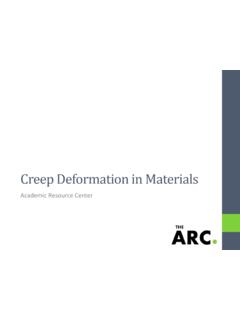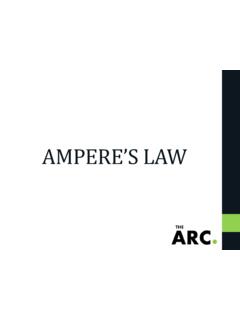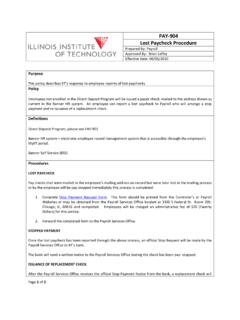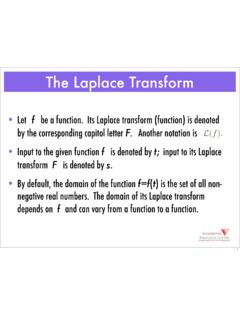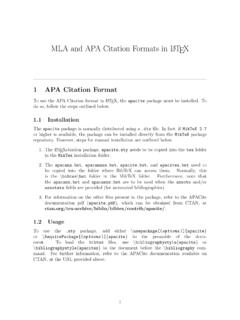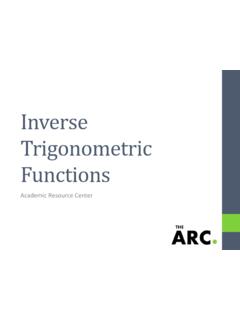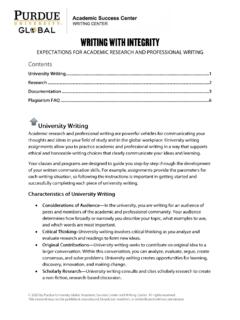Transcription of Cross Product - Illinois Institute of Technology
1 Cross Product Academic Resource Center In This We will give a definition Look at the properties Do some examples Cross Product Definition: If a = <a1, a2, a3> and b = <b1, b2 , b3 >, then the Cross Product of a and b is the vector, a x b = <a2b3 a3b2 ,a3b1 a1b3 ,a1b2 a2b1> = (a2b3 a3b2)i + (a3b1 a1b3)j + (a1b2 a2b1)k Cross Product Note the result is a vector and NOT a scalar value. For this reason, it is also called the vector Product . To make this definition easer to remember, we usually use determinants to calculate the Cross Product . Determinants Determinant of order 2: Determinant of order 3: Cross Product We can now rewrite the definition for the Cross Product using these determinants: If you perform the determinants, you will obtain exactly what was stated in the definition.
2 Orthogonal Vectors When you take the Cross Product of two vectors a and b, The resultant vector, (a x b), is orthogonal to BOTH a and b. We can use the right hand rule to determine the direction of a x b Parallel Vectors Two nonzero vectors a and b are parallel if and only if, a x b = 0 Examples Find a x b: a = <1,4,-1> and b = <2,-4,6>, a x b = (a2b3 a3b2)i + (a3b1 a1b3)j + (a1b2 a2b1)k = (4*6 (-1)(-4))i + ((-1)*2 1*6)j + (1*(-4) 4*2)k = (24 4)i + (-2 6)j + (-4 8)k = 20i 8j 12k = <20,-8,-12> a = j + 6k and b = i + j, a x b = ((1)(0) 6(1))i + (6*1 0*0)j + (0*1 1*1)k = 6i + 6j k = -6i + 6j k = <-5,6,-1> Alternative Method Another way to calculate the Cross Product of two vectors is to multiply their components with each other.
3 (Similar to the distributive property) But first we need to know, An easier way to memorize this is to draw a circle with the i, j, and k vectors. Clockwise relates to the positive orientation and counter clockwise is the negative orientation. Alternative Method (cont.) Note that, i x j j x i Therefore, the Cross Product is not commutative and the associative law does not hold. (a x b) x c a x (b x c) Cross Product Properties of the Cross Product : If a, b, and c are vectors and c is a scalar, then 1. a x b = b x a 2. (ca) x b = c(a x b) = a x (cb) 3. a x (b + c) = a x b + a x c 4.
4 (a + b) x c = a x c + b x c 5. a (b x c) = (a x b) c 6. a x (b x c) = (a c)b (a b)c Example If a = 3i +2j + 5k and b = i + 4j +6k, find a x b and b x a a x b = (3)(1)(i x i) + (3)(4)(i x j) + (3)(6)(i x k) + (2)(1)(j x i) + (2)(4)(j x j) + (2)(6)(j x k) + (5)(1)(k x i) + (5)(4)(k x j) + (5)(6)(k x k) = 12k 18j 2k + 12i +5j 20i = 8i 13j + 10k b x a = 2k 5j 12k + 20i + 18j 12i = 8i + 13j 10k Cross Product If the angle between the two vectors a and b is , then |a x b| = |a||b| sin (Note that |a x b| is the magnitude of the vector a x b) Example Find the angle between a and b.
5 A = <-4,3,0> and b = <2,0,0> |a| = 5 |b| = 2 a x b = <0,0,-6> |a x b| = 6 sin-1(6/(5*2)) = sin-1(3/5) = Example Find |u x v| and determine whether u x v is directed into the page or out of the page. |u x v| = |u||v| sin = 5*10*sin 60 = From the right hand rule, going from vector u to v, the resultant vector u x v is directed into the page. Cross Product The length of the Cross Product a x b, |a x b|, is equal to the area of the parallelogram determined by a and b. Example Find the area of the triangle with the vertices P(0,1,4), Q(-5,9,2), and R(7,2,8): PQ = <-5,8,-2> and PR = <7,1,4> PQ x PR = <34,6,-61> Area of parallelogram = |PQ x PR| = ( 342 + 62 + (-61)2) = 17 (17) Area of the triangle = 17 (17)/2 35 Cross Product The volume of the parallelepiped determined by the vectors a, b, and c is the magnitude of their scalar triple Product : V = |a (b x c)| where, If the triple scalar Product is 0, then the vectors must lie in the same plane, meaning they are coplanar.
6 Example Find the volume of the parallelepiped determined by the vectors a, b, and c. a = <6,3,-4>, b = <0,2,1>, c = <5,-1,2> b x c = <5,5,-10> a (b x c) = <6,3,-4> <5,5,-10> = 85 Volume = |a (b x c)| = 85 References Calculus Stewart 6th Edition, Section The Cross Product

